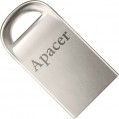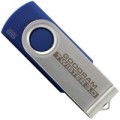USB version
The method of connecting a flash drive to a PC (laptop) provides both a connector (plug type) and an interface (speed). Among these are:
USB 2.0,
USB 3.2 gen1,
USB-C,
microUSB and
Lightning. More details about each of them:
—
USB 2.0. A universal interface used in computer technology to connect a wide variety of devices, including external drives. Version 2.0 provides data transfer rates up to 480 Mbps and is the most common today; almost all models of computers and laptops, and even some tablets, are equipped with such a port (often more than one). Note that the term "USB 2.0" in this case means an interface that uses a classic USB connector; models with a Type-C plug are listed in a separate category (see below).
—
USB 3.2 gen1. An improved version of the USB standard. It provides a 10-fold increase in data transfer speed (up to 4.8 Gbps) compared to the USB 2.0 revision, as well as higher power output, making it easier to connect multiple devices to a single port via a hub. As with USB 2.0 (see above), this category includes devices with the classic full-size USB connector. USB 2.0 and 3.2 Gen1 standards are mutually compatible — meaning that a USB 3.2 Gen1 port can easily connect to a second-generation device and vic
...e versa. The speed will naturally be limited by the slower interface, i.e., USB 2.0. At the same time, manufacturers may label their flash drives as 3.1 (the former name of the current 3.2 Gen2 interface), but the speeds indicate that this is not the second generation, but the first, i.e., 3.0 under the previous name. With the changing interface names, it can become even more confusing, so look directly at the speed indicators, which will more accurately describe the performance of the model.
— USB 3.2 gen2. The next major update to the USB interface after USB 3.2 Gen1 (previously also known as USB 3.1 Gen2 and USB 3.1). The maximum connection speed has doubled compared to the previous version — almost reaching 10 Gbps. As is typical for the standard, this interface uses a USB-A connector and is backward compatible with previous revisions — USB 2.0 and 3.2 Gen1. The only caveat is that the operating speed will be limited by the capabilities of the slower version.
— microUSB. A kind of "mobile" version of the USB standard, used in portable devices like smartphones and tablets. Accordingly, flash drives with such a connection interface are designed specifically for mobile gadgets, or rather, for equipment that supports the USB OTG function (see "Functions / Capabilities"). To connect via USB OTG peripherals with a regular USB plug, you would have to use an adapter, and a microUSB flash drive can be plugged in directly. At the same time, the design of such flash drives can also include a classic full-size plug, which makes them very versatile.
— USB-C. Formally, USB-C is not a separate connection interface, but a type of connector through which a connection can be made using one of the USB versions described above. The connector itself is significantly different from the classic USB connector. Firstly, it has a smaller size and can be used with equal ease in both stationary and portable equipment. Secondly, it is made double-sided, which greatly facilitates the connection: the plug can be inserted the first time even blindly, without worrying which side to turn the flash drive. This plug is not compatible with earlier USB ports, which is why USB-C flash drives are most often used in parallel with a regular full-size plug.
— Lightning. Also known as 8-pin. Apple's proprietary connector used in portable equipment (primarily iPhone and iPad), since 2012. Accordingly, the Lightning connector is equipped with flash drives designed for use with "apple" gadgets. Moreover, this interface, usually, is not the only one — it usually complements the standard USB connector.Read speed
The maximum speed of reading data from the drive. The
higher this speed, the faster you can rewrite information from a flash drive to a computer disk, which is especially important when working with large amounts of data. In fact, the reading speed depends on a number of factors, including the interface bandwidth (see Connection interface), the design features of the drive and computer, the software used, system load, etc.
Write speed
The maximum speed of writing data to the drive. The
higher the write speed, the less time it takes to transfer information from a computer to a USB flash drive, which is especially critical for large amounts of data. Just like the read speed, in fact the write speed is determined by a number of factors, in particular, the connection interface (see Connection interface), the design features of the drive, system load, etc.
Retractable connector
The USB flash drive has a USB plug that can be pulled out of the case during use and hidden in it during storage. This is convenient, first of all, because such drives do not need a protective cap, which can be easily lost; however, on the other hand, retractable connectors are considered less reliable than fixed ones.
Swivel housing
In the design of
flash drives with a swivel case, there is a bracket fixed on the outside, which rotates around the axis and closes access to the USB plug. There is no protective cap for the connector; as a result, it is not protected from dust and moisture. The basic protection of the connector is provided only against mechanical damage.
Material
—
Plastic. Inexpensive and at the same time quite practical material. Plastic allows you to create cases of almost any shape and colour — from classic to very original; yet it is strong and reliable enough to protect the flash drive during normal household use and even in some adverse situations. At the same time, the strength and impact resistance of plastic are relatively low, and in case of serious "troubles" — falling from a great height, stepping on a flash drive, etc. — such a case with a high degree of probability will be damaged. However, such situations rarely occur, and there are quite a few varieties of plastic, some of them are very durable. Therefore, this material in modern flash drives is extremely popular.
—
Metal. Metal combines high strength and reliability with a stylish appearance; flash drives made of this material look solid and are able to withstand fairly strong impacts that would damage a plastic product. Such cases can be heavier than plastic, but this cannot be called a disadvantage: the weight of modern flash drives is not so large that it creates inconvenience, and the massiveness of the product enhances the impression of solidity. But of the unequivocal disadvantages of metal, one can name a higher cost than plastic.
—
Rubber. Rubber is quite easy to work with and is suitable for creating complex shaped cases; many flash driv
...es made from this material are of the original design. The main practical feature of rubber is elasticity. This makes the case quite shock-resistant and allows you to endure strong short-term pressure without consequences (for example, if you step on the product). At the same time, rubber is somewhat more expensive than plastic, and the advantages mentioned in most cases are not of key importance. Therefore, this material is much less common.
— Skin. Leather by itself is not suitable as a body material; therefore, in this case, we are usually talking about a leather covering on a solid base — metal or plastic. See above for more details on these materials; as for the skin, this material gives the flash drive a rich and solid appearance, but it is not cheap, and from a practical point of view it does not provide any special advantages. Therefore, cases with leather inserts are the prerogative of fashion models, for which not only functionality is important, but also an expensive representative design.
— Wood. From a practical point of view, wood has no advantages over plastic, while it is noticeably more expensive and more difficult to manufacture — in particular, because special processing is required for moisture resistance and strength. The advantage of this material can be called an attractive appearance; in addition, some users consider wooden cases to be the most "green" or pleasant to the touch. As a result, such cases are rare — only in designer models of "flash drives", created in order to stand out among plastic and metal products.Manufacturer's warranty
Manufacturer's warranty provided for this model.
In fact, this is the minimum service life promised by the manufacturer, subject to the rules of operation. Most often, the actual service life of the device is much longer than the guaranteed one. But an indicator of
5 years suggests that the flash drive is more likely to be lost or become irrelevant. You can also come across
a lifetime warranty, however, in this case it is better to drown out the details to which it applies. And anyway, it implies a certain period of time, though measured in decades. In addition to confirmation of reliability, such a guarantee allows you to contact the supplier after a while to eliminate possible problems (of course, not mechanical). But the difficulties in implementing this procedure (the representative office is located only in large cities) and the rare cases of the need for this (after all, it is easier to buy a new flash drive, with the exception of vital information on the old media) make the lifetime warranty more of a marketing ploy than a cool chip.

